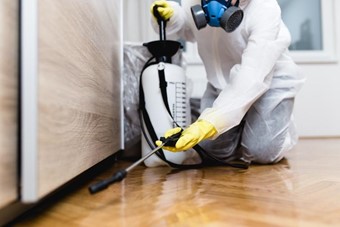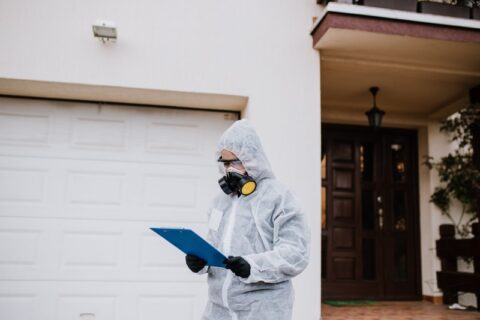Prep Your Home for Your Bug Extermination … This Is War!
So, it’s official: Your homestead has been invaded by pests. You may have ants scurrying around the kitchen or termites chewing up the entire house from the inside out.
The pest control expert you hired has confirmed the bad news and has given you a clear idea as to the extent of the infestation. They’ll be arriving in a few days to begin the process of getting rid of all these unwanted visitors, but, in the meantime, what, if anything, can you do to prepare?
As it happens, there are a few things you can do that will make matters easier for your pest control technician. Don’t worry—it’s mostly just a matter of carrying out some normal house cleaning and rearranging the furniture a little. Having said that, here are a handful of tips for preparing your home prior to the visit from your exterminator.
Clean the Place
This is the #1 piece of general advice that you should follow before the pest control pro arrives. The purpose of this is not to make your home look nice for visitors but to help the technician perform their duties properly. For exterminators, a cluttered home is hard to work with for a number of reasons, including but not limited to the following:
Piles of household stuff can easily harbor pests, and your technician will not sit there digging through your things to find them.
Your technician needs to be able to access all areas of the home, even those that you seldom use.
Giving your house a thorough cleaning serves to get rid of all those random food crumbs that tend to accumulate around the house and attract pests.
Pest control chemicals may not work effectively when applied to dirty surfaces.
Exactly what and how should you clean to make your pest control experience go as smoothly as possible? Keep reading.
Listen to the Technician
The person who inspects your home for pests may have specific guidelines that you should follow. Please don’t ignore them—they’ve seen your house, they know exactly the nature of your issue, and they may have suggestions that we haven’t covered in this general survey. Also, your home preparation should ideally take into account the particular type of pest(s) infesting the premises.
Cover Up Open Food
A lot of us are in the habit of leaving opened food containers, like potato chip bags, lying around for easy access. The problem is, you’re also granting easy access to small insects as well. Be sure all these containers are properly sealed prior to the technician’s arrival. Incidentally, this is a good way to help prevent insect infestations all year round.
Cover Kids’ Toys
You don’t want pest control chemicals to get on your children’s toys or bedding, so pack up all these things and put them safely away somewhere before the exterminator knocks on your door.
Vacuum the Floor
Giving your house a vigorous vacuuming helps get rid of any bug eggs that might be lying around. You tend to find flea eggs along the perimeter of a room, so this area needs special attention. A crevice attachment tends to aid in getting to hard-to-reach spots. This will also serve to pick up food crumbs that can attract various pests and lure them away from the traps that your technician might set up around the home.
Once you’re done the vacuuming, though, you need to be careful about disposing of the contents of the bag—live pests could be in there. Put the contents into a carefully sealed bag, then dispose of it immediately. As an extra safety measure, you could also consider wiping down the vacuum cleaner itself with a damp towel.
Using a steam cleaner on the carpets and flooring is also highly effective. If you have one, you should use it on the drapes and upholstery as well.
Take Out the Trash
Whatever you do, don’t just clean up the whole house and leave all that junk sitting in a trash can in the kitchen. Any pests in there could easily escape and begin exploring the area nearby. The best tactic is to take the trash to a dumpster away from your property.
Turn Off Your Fish Tank
If you own a fish tank, be sure to turn off the pump and put the cover on it. You can return it to normal operation after the pest control agent has been applied and—assuming you have to vacate the premises for a while—you have the go-ahead to re-enter the home.
Guidance for Specific Types of Pests
What we have listed above are sound general rules. Now we’ll look into strategies for specific types of infestations.
For Ants & Roaches
- Remove all objects from your window sills (e.g., plants).
- Remove all objects from the rear of your countertop.
- Remove all objects from the perimeter of each room being treated.
- Clean out the cabinets in your kitchen and bathroom.
- Mop the floors.
- Clean the countertops and window sills.
After the technician applies the pest control solution, it may be necessary to leave the premises for a few hours—and don’t forget to bring your dogs or cats with you. When you return, try to resist the temptation to clean the floors and countertops right away, as lingering effects of the applied chemicals can continue to kill these pests for several months to come.
For Spiders
- Remove all objects standing 18” or less from a wall. Let large, bulky beds and shelving stand if they cannot be safely moved.
- Clean out the area underneath the beds.
- Remove all objects standing 18” or less from the perimeter of your garage. Again, large shelving may be left in place if necessary.
- Clean the flooring along the walls.
As with the ant/roach treatment, you can expect to leave the premises for a few hours after the chemical treatment has been applied. Also, delay in cleaning treated areas for at least a couple of weeks. This will leave the spider-killing chemical in place and eliminate critters not harmed by the initial application.
For Fleas
- Remove your bedding and wash it thoroughly.
- Dry your bedding materials in the dryer on the hottest temperature (taking into consideration the type of material in question).
- Place dried bedding in garbage bags or, preferably, airtight containers.
- Clear out the closets.
- Clear out the area under the beds.
- Remove rugs and beat them outdoors. It’s also a good idea to wash them afterward.
- Remove as much furniture as you can from the carpeted flooring. Place all these relocated items on hard flooring, away from the walls.
- Vacuum the flooring. Be sure to reach the perimeter of the room.
After treatment, you may have to leave the premises for a few hours. It could take several weeks for the flea infestation to be finally resolved. During this period, try not to clean the areas where the flea chemicals have been applied.
Keep in mind that all of this is just general guidance for preparing your home before the pest control professional comes to save the day. The main thing is to listen to whatever the technician advises you to do, which may include steps not covered here. If you have any questions or concerns about what you need to do, be sure to reach out to them as soon as possible. That’s the best way to ensure that you get the most out of your pest control experience.


